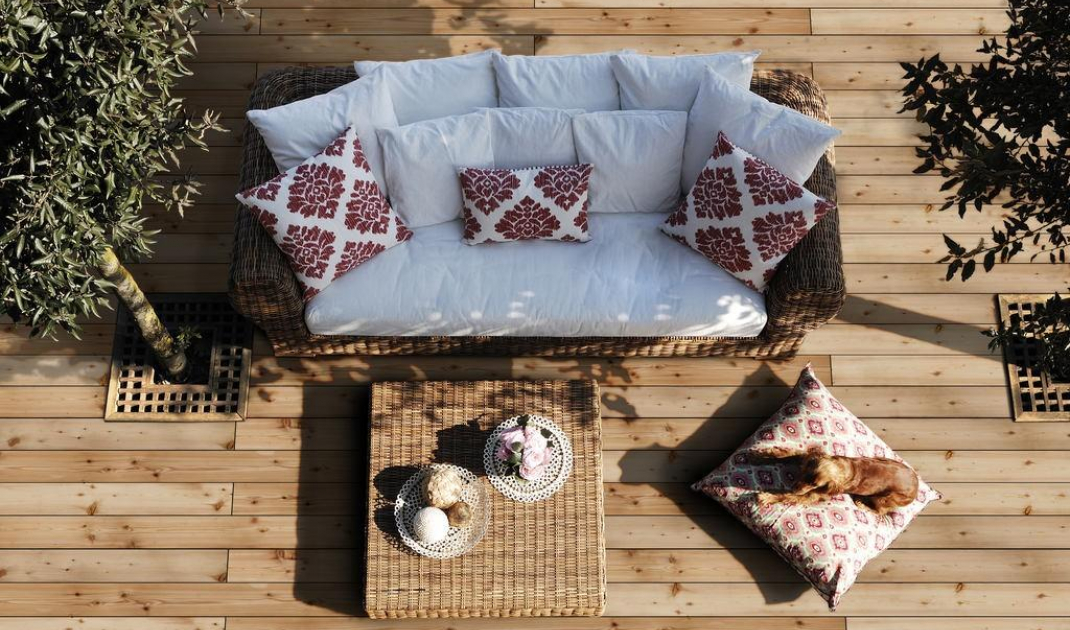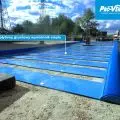The terrace is not only an ornament of the house, but also a charming meeting place. Its appearance is most influenced by the material from which it is built. So how do you choose the right wood for a terrace?
What to follow when choosing wood for a terrace?
When choosing the type of wood that will be placed on your terrace, consider first of all its durability. This includes both durability and resistance to damage, weather conditions, as well as abrasiveness. Different species differ quite significantly in this regard. We must also consider the subsequent care of the wood. Let's also pay attention to the warranty offered by the manufacturer. It is worth considering buying already finished and preserved boards. This way we won't have to bother with cleaning, polishing and smoothing the surface. In addition, we must choose between the variant of grooved boards, that is, vertically grooved, or smooth. The grooves make it easier for water to run off, so the terrace will be more secure, even in the rain. Moreover, any, damage, knots and blemishes will be less visible. On the other hand, smooth boards are much easier to keep clean.
Composite boards from the Duna collection
© DLH
European wood
A terrace made of European wood species is most often constructed of pine or spruce. These species are cheap and easy to machine. This wood, is also valued for its pleasant forest smell. Unfortunately, it is also characterized by a rather low durability. So it is better not to choose it for a very heavily used terrace. Another option is larch decking. This species is very popular because of its intriguing, falling into red color. Larch is very resistant to mechanical damage and weather conditions. In addition, with proper protection, on a terrace made of larch, we will not have a problem with pests and fungi. Oak planks are hard and heavy. Oak wood takes on a color ranging from yellowish-white to olive-brown. It is extremely durable against biological agents. It does not need to be impregnated, but it is worth using special products that will prevent the loss of its beautiful color.
Wooden decking board
© DLH
Exotic wood
One of the most popular exotic species is teak wood. It is characterized by high durability and resistance, both to mechanical damage and external factors. Moreover, it will not be destroyed by insects either. Thanks to its high content of silicic acid and oily substances, it is resistant to water. At the same time, it does not cause problems in processing. Thanks to growing in harsh atmospheric conditions, Merbau wood is extremely resistant to mechanical actions and moisture, and even to chemicals and food acids. The surface of Merbau wood planks is perfectly planed, making them smooth and safe. They do not rot and practically do not absorb moisture. So they are ideal for harsh weather conditions on the terrace. You can choose from wood in many shades of brown. From dark with golden highlights, through falling into red, to yellowish. Bangkirai wood is naturally protected against water due to the oils and tannins it contains. For its impregnation, varnishes are not used, but oils. Bangkirai wood planks are resistant to abrasion and are available in many shades. Exotic wood is characterized by high resistance to damage and moisture. However, it comes with a correspondingly higher price. It should also be remembered that for their installation we must use only stainless steel or brass screws. This is because exotic wood planks react with iron.
Composite boards
They are made from a combination of polymer mix and wood fibers. This material can be recycled. Composite boards combine the aesthetic qualities of wood with much higher durability. They do not have knots and do not deform. Uniform color makes the whole terrace made of them look consistent and elegant. Composite boards are resistant to temperature fluctuations and water. Unlike wood, we do not have to worry about rotting and insects. They also do not require impregnation. We can even dispense with oiling. This will save us a lot of time and money. Importantly, composite boards are resistant to heavy loads and sunlight. They also have an anti-slip surface. Their price remains at an average level.
Composite board
© DLH
Care of a wooden terrace
Unprotected wood loses its color. It can also crack or become infested with pests. If you fail to protect your decking boards, you will quickly have to replace them with new ones. Before impregnating, the wood must be properly prepared. Raw boards must be sanded and leveled. Then, using extraction gasoline, we remove any resin and dirt. Finally, the boards need to be dried. If we renew the surface, we need to remove the old protective coating. To do this, it is best to use sandpaper. We should impregnate the wood twice a year: in spring and autumn. It is best to choose a colored impregnant and a colorless varnish. Acrylic paints, which are not resistant to outdoor conditions, will not work on the terrace. In addition, it is recommended to regularly care for terrace wood with wood oil. Manufacturers offer preparations in many shades, so we can easily match the color to our arrangement. Oils for specific wood species are also available. To adequately protect the boards, two coats of oil should be applied at an interval of at least 6 hours. The product is applied with a brush or sponge. About a quarter of an hour after applying the oil, remove excess product with a cotton cloth.
How to clean a wood terrace?
First of all, remember to regularly remove such dirt as sand, mud or leaves. This is best done with a soft brush or broom. Stronger dirt is best removed with a hard brush. A pressure washer will also work great. Note, however, that in the case of coniferous wood, care should be taken that the pressure is not too high, as the boards may be damaged. In winter, remember to remove snow regularly. We must also not allow an icy layer to form.





























